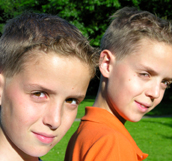When Only One Twin Gets a Disease
Identical twins share the same set of genes, such as ones for thick eyelashes or a pointy nose – as well as the genes that boost risk for diseases. But sometimes rheumatoid arthritis, cancer, or another malady strikes one twin and not the other. What leads to such seemingly capricious twists of fate?

New research comparing gene expression in pairs of identical twins in which only one twin has a disease is trying to answer that question, looking at how the environment or other factors interact with genes to increase disease risk.
One such study, published this month in the journal Arthritis and Rheumatism, has identified three new genes involved in rheumatoid arthritis. It could eventually shed light on the factors that trigger the disease in genetically susceptible individuals.
Many diseases are caused by a combination of environmental and genetic factors. In rheumatoid arthritis, for example, “an allergen or virus might trigger in a genetically susceptible person the expression of genes that cause inflammation and other problems,” says Eric Matteson, a rheumatologist at the Mayo Clinic in Rochester, NY.
Identical twins provide an ideal setting to study this complex interaction. While they share the same genes, they sometimes differ in how these genes are expressed. In the recent study, scientists at the University of Michigan studied 11 pairs of twins in which one member of the pair had rheumatoid arthritis, an auto-immune disease that destroys the tissue lining the joints. Experts say that genetics accounts for about 60 percent of the occurrences of the disease, while other factors, such as infections or exposure to toxins, are responsible for the remaining 40 percent. And both members of an identical twin pair don’t usually have the disease; if one twin has it, the other will have it about 15 percent of the time. “That’s a strong indication that beyond genes, something else needs to happen,” says Joseph Holoshitz, a rheumatologist at the University of Michigan Medical School in Ann Arbor, who led the study. “What that is, we still don’t know.”
Holoshitz and his team analyzed gene expression patterns in each duo, looking for genes that were either under- or over-expressed in those with the disease. They found three previously unidentified candidates that were highly expressed in the joints of the affected twin. One gene codes for an enzyme that’s thought to neutralize cortisol, an anti-inflammatory compound. (Rheumatoid arthritis patients have long been known to be deficient in cortisol.) Another gene codes for a protein that facilitates the formation of new blood vessels, which is part of the inflammation process in the disease. The third gene is thought to be involved in digesting proteins and might contribute to tissue destruction at the joint.
The researchers aren’t yet sure what triggers these differences in gene expression. But epigenetic changes – nongenetic factors that change the way DNA is packaged or labeled – are a likely culprit. “It could be that at a certain point in their lifetime, the twin with the disease got epigenetic modifications of certain genes that didn’t happen in the healthy twin,” says Holoshitz. Epigenetic changes can occur randomly or from environmental influences.
Several experts say the findings are exciting, yet preliminary. “It will be important to try to study these genes in greater detail and in other populations, to try to confirm and understand how they play a role in disease,” says Lindsey Criswell, a scientist who studies arthritis at the University of California, San Francisco. She adds that because the researchers studied subjects who already developed the disease, it’s unclear if the abnormal expression patterns were a consequence of the disease or actually led to its onset. Studying patients diagnosed in the earliest stages of rheumatoid arthritis could help tease that out, she says.
Larger studies are already underway. Frederick Miller, chief of the Environmental Autoimmunity Group at the National Institute of Environmental Health Sciences in Bethesda, MD, is spearheading a study of twins and siblings with rheumatoid arthritis, lupus, and scleroderma to determine the specific environmental exposures and genetic factors that contribute to these diseases. His team will look at some of the genes highlighted in the Michigan study. Once they identify specific environmental triggers for the diseases, they’ll try to find a link between the two.
Miller says the Michigan study is proof that this approach can identify novel proteins and genes involved in disease processes. He adds that the study was unique because the scientists were able to find 11 pairs of suitable twins – a challenging task for a relatively uncommon disease. A handful of such twin-based studies have been conducted in autism, multiple sclerosis, and other diseases, but most of them focused on fewer pairs.
Holoshitz is also planning further experiments. He wants to figure out, among other things, whether blocking the culprit genes can help to slow the pain and inflammation of arthritis.
Deep Dive
Biotechnology and health
How scientists traced a mysterious covid case back to six toilets
When wastewater surveillance turns into a hunt for a single infected individual, the ethics get tricky.
An AI-driven “factory of drugs” claims to have hit a big milestone
Insilico is part of a wave of companies betting on AI as the "next amazing revolution" in biology
The quest to legitimize longevity medicine
Longevity clinics offer a mix of services that largely cater to the wealthy. Now there’s a push to establish their work as a credible medical field.
There is a new most expensive drug in the world. Price tag: $4.25 million
But will the latest gene therapy suffer the curse of the costliest drug?
Stay connected
Get the latest updates from
MIT Technology Review
Discover special offers, top stories, upcoming events, and more.